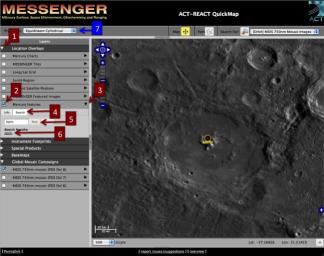How to Locate the Newly Named Craters
Caption:
The above image is a view of the
QuickMap tool
, available from the "
Explore Orbital Data with QuickMap
" button on the left side of this page. You can easily locate the
nine newly named craters
on Mercury by following these simple steps:
First, open
QuickMap
. Then:
1)
Click on the triangle to the left of "Location Overlays"
(1 in above image)
2)
Click on the box to the left of "Mercury features"
(2 in above image)
3)
Click on the triangle to the right of "Mercury features"
(3 in above image)
4)
Click on the tab labeled "Search"
(4 in above image)
5)
Type the
name of a newly named crater
into the box and click on "Find"
(5 in above image)
6)
Click on the crater name and QuickMap will take you there!
(6 in above image)
Have fun exploring Mercury's newly named craters and much more!
[As a note, the newly named craters Disney, Kobro, and Komeda are located in Mercury's southern region and may be easier to explore by changing the map projection to "South Polar Stereographic."
(7 in the above image)
]
Background Info:
The MESSENGER spacecraft is the first ever to orbit the planet Mercury, and the spacecraft's
seven scientific instruments and radio science investigation
are unraveling the history and evolution of the Solar System's innermost planet. Visit the
Why Mercury?
section of this website to learn more about the key science questions that the MESSENGER mission is addressing. During the one-year primary mission, MDIS acquired 88,746 images and extensive other data sets. MESSENGER is now in a year-long extended mission, during which plans call for the acquisition of more than 80,000 additional images to support MESSENGER's science goals.
For information regarding the use of images, see the MESSENGER
image use policy
.
Cataloging Keywords:
| Name |
Value |
Additional Values |
| Target |
Mercury |
|
| System |
|
|
| Target Type |
Planet |
|
| Mission |
MESSENGER |
|
| Instrument Host |
MESSENGER |
|
| Host Type |
Orbiter |
|
| Instrument |
|
|
| Detector |
|
|
| Extra Keywords |
Color, Crater, Map, Radio |
| Acquisition Date |
|
| Release Date |
2012-12-21 |
| Date in Caption |
|
|
| Image Credit |
NASA/Johns Hopkins University Applied Physics Laboratory/Carnegie Institution of Washington |
| Source |
photojournal.jpl.nasa.gov/catalog/PIA16664 |
| Identifier |
PIA16664 |

 Planetary Data System
Planetary Data System
